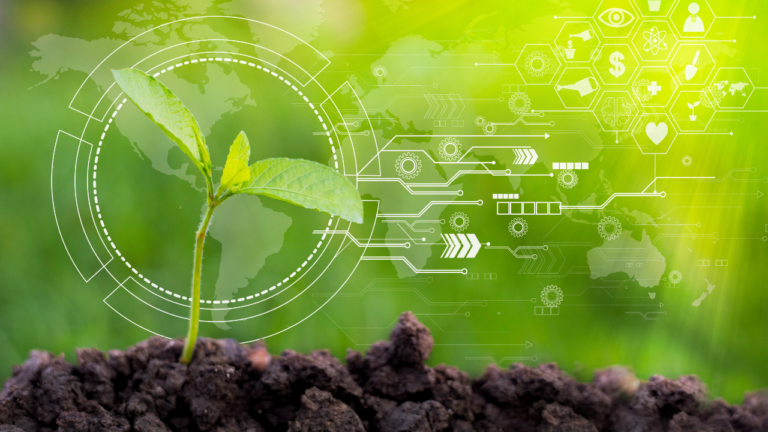Green Tech: Smartphones Pioneering Sustainability
The evolution of the smartphone from a mere communication tool to an indispensable epitome of modern technology has been nothing short of astounding. This rapid transition not only highlights human ingenuity but also underscores the fierce competition between two tech giants: iOS and Android.
Beyond mere market dominance, their rivalry drives relentless innovation, constantly pushing the boundaries of what is achievable in mobile technology. This exploration delves deep into the heart of this technological revolution, focusing on recent advancements that have captivated enthusiasts and everyday users alike.
Our journey begins with groundbreaking hardware advancements that redefine user interaction and software innovations that enhance functionality. We’ll explore the realms of advanced networking, including the transformative potential of 5G, immersive augmented reality experiences, robust security features for safeguarding our digital lives, and the imperative for environmental sustainability in computing.
Furthermore, we’ll examine how these technological leaps have reshaped the user experience, democratizing access to technology and integrating it seamlessly into our daily lives. Join us as we embark on this captivating exploration of the latest in smartphone technology.
Today, the hardware within smartphones rivals that of high-end computers and professional cameras, a testament to the steady progress of smartphone technology. Significant advancements in display technology, camera systems, and battery life have been pivotal.
OLED and AMOLED screens, for instance, have revolutionized display technology, offering brighter colors, deeper blacks, and higher contrast ratios. Apple’s iPhone 12 Pro Max boasts a Super Retina XDR display, delivering immersive visuals with remarkable detail and clarity. Similarly, the Samsung Galaxy S21 Ultra features a Dynamic AMOLED 2X panel with a 120Hz refresh rate, enhancing smoothness in scrolling and responsiveness in games. These improvements elevate every aspect of the user experience, from video streaming to app usage, making it more enjoyable overall.
Camera Systems
Smartphone photography has come a long way, and now phones have multi-lens systems that are on par with DSLR cameras. For example, the iPhones models higher than 12 Pro Max have triple-camera systems with advanced features like Deep Fusion and Night mode that let you take professional-quality pictures even when there isn’t much light. In the same way, the Google Pixel 5, an amazing Android phone, is praised for its amazing computational camera skills, which make pictures that look much better than their apparent simplicity. These improvements have made photography more accessible by letting anyone take, edit, and share pictures and videos of professional quality right from their phones.
Battery Life:
As smartphones continue to grow in power, ensuring they can endure a full day of intensive usage has become crucial. Thanks to advancements in battery technology, including larger and more efficient batteries alongside adaptive charging methods, battery life has seen significant improvements. Notably, flagship models like the iPhone 12 Pro Max and the Samsung Galaxy S21 Ultra are equipped with intelligent power management systems that sustain usage throughout the day, even under heavy loads. This addresses concerns about running out of power during prolonged gaming sessions, binge-watching sessions, or extensive multimedia usage.
These hardware enhancements not only enhance smartphone performance but also blur the boundaries between smartphones and traditional computing and photography equipment. From gaming experiences with graphics rivaling those of consoles to capturing breathtaking photos and enjoying cinematic-quality movies, the latest iOS and Android smartphones have set a new standard for technological expectations. They have become indispensable tools for fostering creativity, providing entertainment, and enhancing daily productivity.
In the software domain, the divergence between iOS and Android becomes more pronounced, with each offering unique features tailored to diverse user preferences. The latest iterations of their operating systems, iOS 15 and Android 11, introduce a plethora of enhancements aimed at refining the user experience, emphasizing personalization, security, and seamless integration within a broader device ecosystem.
Operating System Features:
iOS 15 introduces innovative features such as Focus Mode, enabling users to filter notifications based on their current activity, thus boosting productivity and minimizing distractions. Another noteworthy addition is Live Text, which allows users to interact with text in photos and screenshots effortlessly for tasks like copying, looking up, and translation. In contrast, Android 11 prioritizes communication and control, with features like Chat Bubbles and Conversations Notifications streamlining messaging across multiple apps, ensuring important messages are never overlooked. Moreover, Android 11 enhances user privacy with features like one-time permissions and automatic permission resets for unused apps, granting users greater control over their data.
App Ecosystems:
While both iOS and Android boast extensive app ecosystems, their approaches differ significantly. The App Store is renowned for its stringent review process, ensuring apps meet high standards for privacy and security before being available to users, fostering a sense of trust among iOS users. Conversely, the Google Play Store offers a more open platform, resulting in a diverse array of apps, including those catering to niche interests. Google has also bolstered security measures with features like Play Protect, which scans apps for malicious behavior, ensuring a safer environment for Android users.
Integration with Other Devices
Both ecosystems excel in integrating with other devices, enhancing the user experience significantly. iOS users benefit from continuity features that seamlessly connect Apple devices. For example, Handoff enables users to start an activity on one device and continue it on another seamlessly. Universal Clipboard, AirDrop, and Sidecar further extend iOS functionality by closely integrating with MacOS, creating a more cohesive ecosystem.
Similarly, Android users enjoy comparable benefits, especially within the Google ecosystem. Features like Phone Hub on Chromebooks enable Android users to manage their phones directly from their laptops, receiving notifications, responding to messages, and accessing recent photos. This level of integration streamlines workflows and personal tasks, blurring device boundaries for a more unified digital experience.
These software advancements and ecosystem integrations underscore how iOS and Android transcend mere operating systems, evolving into platforms that expand device capabilities, enriching user experiences through innovation, security, and seamless connectivity.
The emergence of 5G technology represents a significant leap forward in mobile connectivity, offering speeds up to 100 times faster than 4G. This advancement goes beyond faster smartphone internet; it promises to revolutionize how we interact with the world. 5G’s low latency and high bandwidth capabilities unlock a multitude of possibilities, from real-time data processing in autonomous vehicles to remote surgeries facilitated by instantaneous communication. For consumers, 5G translates to seamless HD media streaming, near-instant downloads, and smoother, more reliable online gaming. Furthermore, 5G is poised to drive the proliferation of smart city technologies, enabling more efficient traffic management, energy distribution, and emergency services, ultimately fostering more responsive and livable urban environments.

Augmented Reality (AR) represents another frontier undergoing rapid transformation, enriching user experiences with increasingly sophisticated applications. AR overlays digital information onto the physical world, and with smartphones growing more powerful, AR experiences are becoming more immersive and widespread. Apps like IKEA’s Place allow users to visualize furniture in their homes before purchase, seamlessly blending digital and physical realms. Games like Pokémon GO demonstrate AR’s potential to create engaging, location-based experiences. In education, AR brings abstract concepts to life, enabling students to interact with 3D models in real space, enhancing understanding and engagement with complex subjects like anatomy.
Expanding 5G networks means more opportunities for Augmented Reality (AR) apps. Using the fast, low-latency connections, this makes experiences more engaging and involved. Five-G and augmented reality are leading a digital change that is changing how we connect, learn, work, and play. They are also paving the way for future innovations that will push the limits of what we can imagine.
Recently happened security breaches are a stark warning of how vulnerable our connected world is at a time when worries about digital privacy are growing. With events ranging from illegal access to personal data to complex attacks on financial information, it’s clear that strong security measures are needed right away. In answer, both iOS and Android have added new privacy-protecting security tools. According to iOS 15, Mail Privacy Protection stops senders from knowing when an email is read, and App Tracking Transparency lets users control how their apps are tracked across multiple platforms. By automatically changing rights for apps that haven’t been used for a long time, Android 11 has improved security by lowering the risk of private data being exposed without reason.

Additionally, smartphone makers are becoming more aware of their part in reducing the environmental impact of the tech business. An effort to reduce this impact is Apple’s promise to become carbon neutral in all areas of its business, supply chain, and product life cycle by 2030. Furthermore, Samsung has started the Galaxy Upcycling program to reuse older smartphones for new uses, like as Internet of Things (IoT) devices. This makes them last longer and reduces waste. Still, problems like the need for long-lasting products and less technological trash still exist. Other goals for the future include making production less harmful to the environment and promoting a circle economy in which smartphones are made to be easily taken apart and recycled. This will create a more sustainable connection between technology and the environment.
Improvements to smartphone usability have led to the creation of features that make the experience of using smartphones a lot better for disabled people. Some examples include Apple’s VoiceOver, a screen reader for people who can’t see, which lets users move around their iPhone using movements and hear spoken descriptions of what’s on the screen.
Molly Burke, a blind YouTuber, provides a compelling testimony about the life-changing impact of VoiceOver, which has empowered her to independently use her phone. Android’s Live Transcribe & Sound Notifications offer real-time transcription of conversations and alerts for various sounds, serving as a crucial tool for the deaf and hard of hearing community. Google highlighted a case study demonstrating how this feature helped a deaf school teacher stay engaged in both professional and personal conversations, fostering inclusivity.

Looking ahead, smartphone user experience design is set to become more intuitive and personalized, thanks to emerging technologies like AI and machine learning. These advancements are expected to refine predictive text inputs, improve voice recognition accuracy, and even anticipate user needs by offering suggestions before a request is made. Moreover, AI-driven accessibility features could adapt to individual user behaviors and preferences, creating a more tailored interface that evolves with the user. This shift in design philosophy emphasizes smartphones that not only comprehend our commands but also understand our context and preferences, making technology more accessible and seamless for everyone.
In conclusion, the smartphone industry remains a hub of innovation, with advancements in operating systems, app ecosystems, networking, AR, security, environmental sustainability, and accessibility all shaping the future of mobile technology. The competitive landscape between iOS and Android has spurred these developments, driving continual improvement in the user experience. This rivalry not only propels technological advancement but also ensures that the benefits of innovation reach a wide audience, enhancing the digital lives of millions worldwide.
Looking forward, emerging technologies like AI, machine learning, and potentially quantum computing promise to further revolutionize the smartphone landscape. These advancements will make our devices more intuitive, secure, and personalized, seamlessly integrating into our daily lives in ways we are only beginning to imagine. The journey of the smartphone is far from over; it stands on the brink of new frontiers that will continue to redefine our digital experience, making the future of mobile technology an exciting realm of boundless possibilities.


